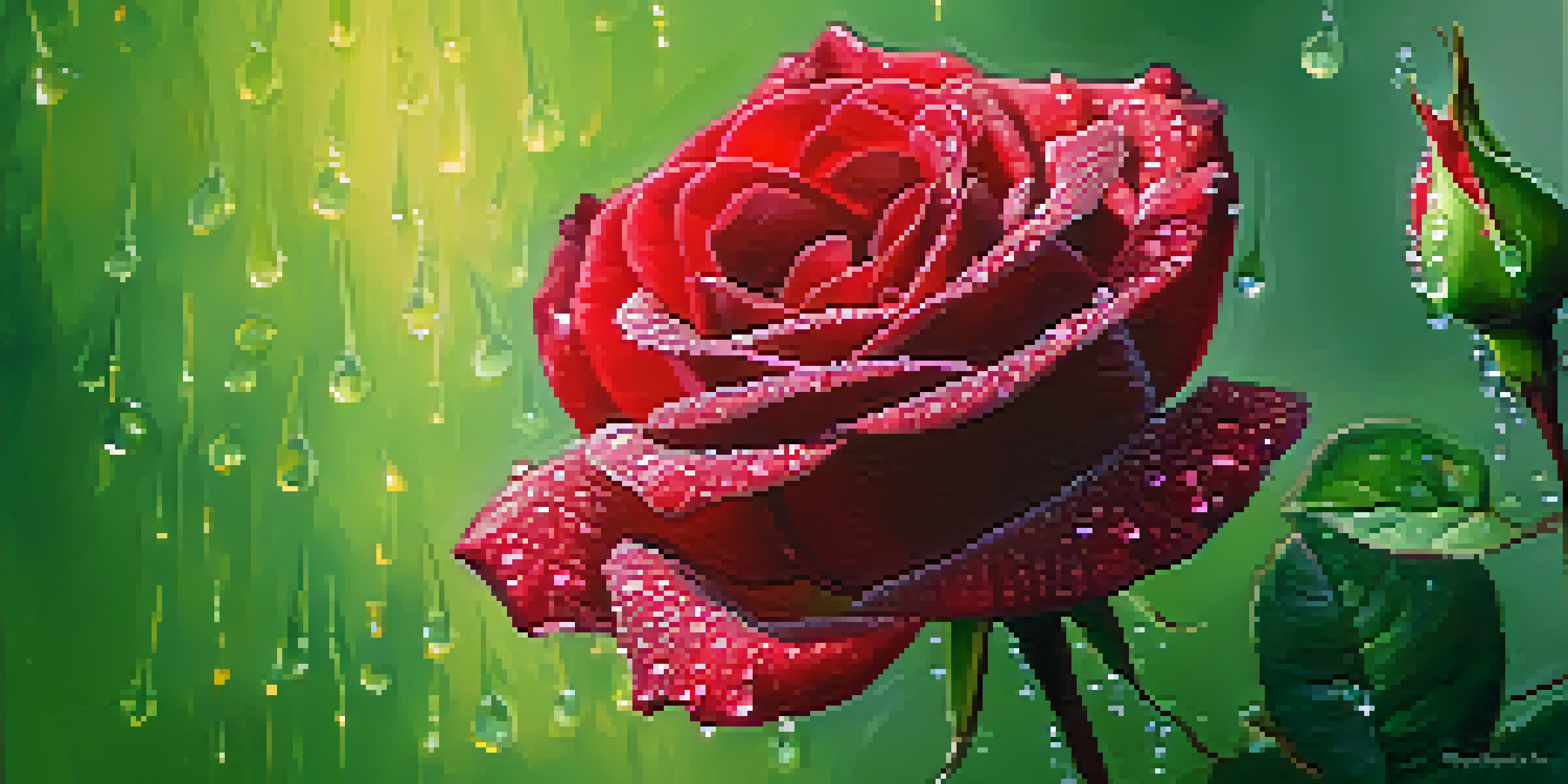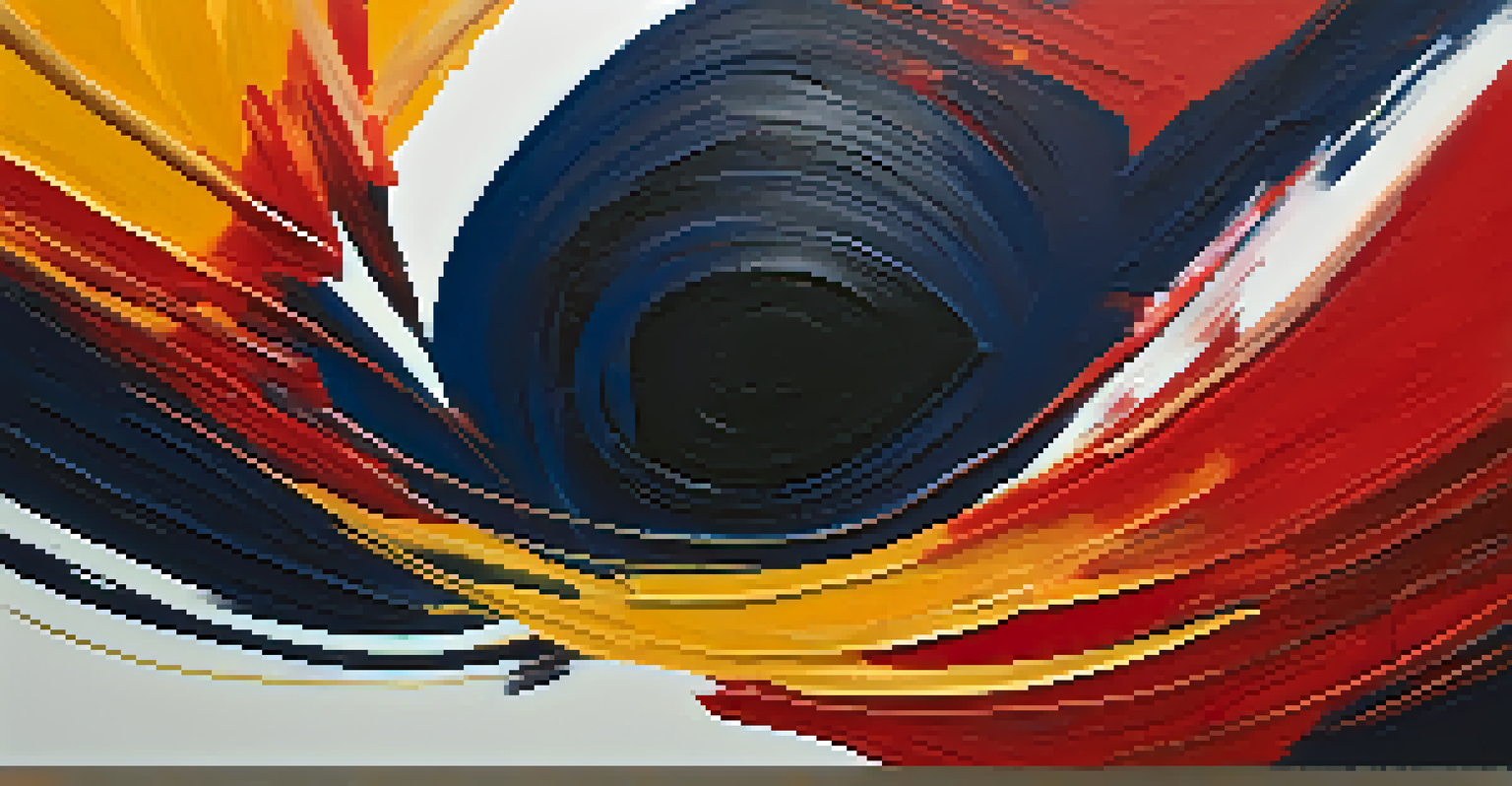Exploring the Impact of Red: Passion and Emotion in Art

Understanding the Color Red: A Symbol of Passion
Red is often associated with intense emotions, primarily passion and love. This vibrant hue can evoke feelings ranging from excitement to anger, making it a powerful tool in the artist's palette. When we see red, it often triggers a biological response, such as increased heart rate, linking it deeply to our emotional state.
Color is the keyboard, the eyes are the harmonies, the soul is the piano with many strings.
Artists frequently leverage this connection between red and emotion to convey their messages. For example, in a romantic painting, shades of red can enhance the sense of intimacy and desire. On the flip side, in a dramatic scene, red might symbolize danger or conflict, illustrating how versatile this color can be.
By understanding how red impacts our emotions, we gain insight into the artist’s intention. This awareness enriches our appreciation of artwork, allowing us to connect with it on a deeper level. Ultimately, red serves as a bridge between the viewer's feelings and the narrative the artist wishes to convey.
Cultural Significance of Red in Art Across the Globe
The significance of red varies widely across different cultures, influencing how it is used in art. In many Eastern cultures, red symbolizes prosperity and good fortune, commonly seen during celebrations like weddings and festivals. This cultural context enriches artworks, giving them layers of meaning that resonate with specific audiences.

Conversely, in Western art, red can represent both love and violence, often seen in pieces that explore human emotions and societal issues. For instance, the use of red in Picasso's 'Guernica' highlights the horrors of war, showcasing the darker side of this passionate color. This duality in meaning offers viewers a chance to reflect on their own experiences with red.
Red's Emotional Power in Art
The color red evokes strong emotions, ranging from passion to danger, and artists use it to convey complex narratives.
Understanding these cultural nuances allows us to appreciate the diversity of artistic expression. It reminds us that while colors like red can evoke universal feelings, their meanings can shift dramatically based on cultural perspectives. This interplay between culture and color makes art a truly global conversation.
The Psychological Effects of Red in Artistic Expression
Psychology plays a significant role in how we interpret colors, including red. Studies show that red can increase energy levels and stimulate mental activity, which artists often harness to evoke specific reactions from their audience. This psychological impact can be particularly effective in modern art, where the aim is often to provoke thought and emotion.
Art is the most beautiful of all lies; it is a poetic interpretation of reality.
For instance, abstract artists might use bold strokes of red to create a sense of urgency or chaos. This technique can invite viewers to confront their feelings, making the artwork an interactive experience. The emotional response to red can also lead to discussions about the themes the artist explores, such as love, anger, or social justice.
By understanding the psychological effects of red, we can engage more deeply with art. It encourages us to question our reactions and the messages behind the colors. This deeper engagement transforms our viewing experience from passive observation to active participation.
Famous Artists Who Mastered the Use of Red
Throughout history, many artists have skillfully utilized red to convey their emotions and narratives. Take, for example, the works of Henri Matisse, who often employed vivid reds to create a sense of warmth and vitality. His paintings invite viewers into a world bursting with life, showcasing how red can celebrate rather than just provoke.
Another notable artist is Mark Rothko, whose large fields of color, including deep reds, evoke profound emotional responses. His abstract works challenge viewers to confront their own feelings, making them a powerful example of how red can communicate complex emotions. Rothko’s art illustrates that the impact of red goes beyond surface aesthetics; it's about the emotional journey.
Cultural Interpretations of Red
Red holds different meanings across cultures, symbolizing everything from love and fortune to violence and conflict.
By studying these artists, we can gain insight into the different ways red can be interpreted. Each artist’s unique style contributes to the broader conversation about color and emotion in art. This exploration also inspires aspiring artists to experiment with red in their own creative journeys.
Red in Contemporary Art: Trends and Innovations
In contemporary art, the use of red continues to evolve, reflecting current societal issues and personal expressions. Artists are experimenting with various shades and techniques, using red to comment on everything from politics to personal identity. This innovative approach keeps the conversation surrounding red fresh and relevant.
For example, street artists often use bold reds to make statements about social justice and community struggles. The vibrancy of red can attract attention, making it an effective choice for work intended to provoke thought and inspire action. This trend highlights the power of color in activism and public discourse.
As we navigate the complexities of modern life, the ways in which artists incorporate red into their work can mirror our collective emotions. This dynamic interaction between color and contemporary themes keeps viewers engaged and encourages ongoing dialogue about the significance of red in today’s art scene.
Interpreting Red: Personal Reflections and Experiences
Our individual experiences with the color red can significantly shape how we interpret it in art. For some, red might evoke memories of love and warmth, while for others, it could stir feelings of anger or loss. This personal connection adds another layer of meaning when we encounter red in artwork.
When viewing a painting that prominently features red, it's essential to reflect on what that color means to you. Consider how it relates to your own life experiences and emotions. This introspective approach can deepen your engagement with the artwork, making it more than just a visual experience.
Red's Role in Contemporary Art
In modern art, red is used innovatively to address societal issues and personal identities, making it a dynamic element in current artistic expression.
By acknowledging our personal interpretations, we contribute to the diversity of perspectives surrounding red in art. Each viewer brings their own story, enriching the overall dialogue. This shared experience underscores the beauty of art: it is as much about the artist's intent as it is about the viewer's interpretation.
The Future of Red in Art: Emerging Trends and Directions
Looking ahead, the role of red in art is likely to continue evolving as new artists emerge and societal contexts shift. With the rise of digital art, we may see innovative uses of red that challenge traditional boundaries. Artists are constantly experimenting, pushing the limits of how color can be used to express complex emotions.
Moreover, as global conversations around mental health and social issues grow, red will likely play a pivotal role in these discussions. Artists may choose to utilize red to represent not just personal passion but also collective struggles. This trend could foster greater understanding of shared human experiences through the lens of color.

The future of red in art is bright and filled with possibilities. As we embrace new technologies and ideas, the emotional depth of red will continue to resonate, ensuring its place as a vital element in artistic expression. This ongoing exploration promises to keep our connection to art vibrant and meaningful.